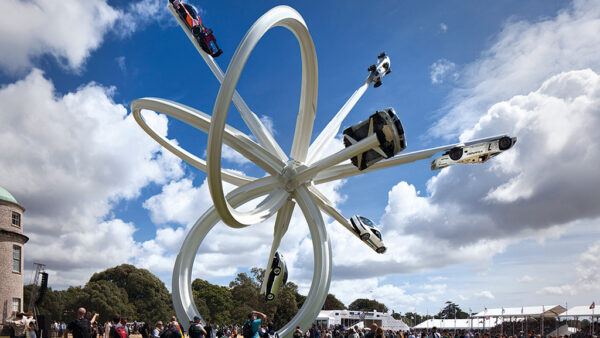
The challenge
Build and complete the 2017 Serpentine Pavilion in a seven-week timeframe using minimal materials.
The context
One of the highlights of London’s cultural calendar, the Serpentine Pavilion has showcased cutting-edge architecture and construction for almost 20 years. This year’s design comes from German-trained, African-born architect Diébédo Francis Kéré. Inspired by his childhood and hometown of Gando, a village in Burkina Faso in western Africa, it uses the concept of the tree as a meeting place, as it had been a key focal point for community in his village.
The 18th Serpentine Pavilion is a huge wooden disc, supported by a central steel framework. The roof is made from recycled timber and modelled on a tree’s canopy. Meanwhile, the inside is enclosed by curving blue walls built from wooden blocks in a textile-like pattern. Although the supporting steel framework appears delicate, it is actually very strong, supporting the 10m cantilever of the roof.
As well as a more sustainable pared-back approach compared to other years, this year’s design also used just four materials including steel, timber, concrete and polycarbonate.

The wall modules were stacked up and glued together in triangular modules and brought to site piece by piece. (Image: Jim Stephenson)

Aecom was engineer and design consultant, working alongside York-based contractor and manufacturing firm Stage One to deliver the project in time for opening on 23 June. With just seven weeks scheduled in to deliver the structure, it was decided that much of the build would be done using prefabrication methods.
According to Michael Orr, engineer at Aecom, the company worked with Stage One on various options, but the main challenge was making the walls structurally sound: “We went through various scenarios but it was decided the walls would be made from solid modules of timber. They are about 175m wide and that split into triangles and then they are built up like Christmas trees and guided together.
“The walls also have a little bit of a gap between them – connecting timber together is not the easiest thing to do so it was decided to prefabricate as much as possible.”
The solution
Prefabrication was done by Stage One in its facility since March. The wall modules were stacked up and glued together in triangular modules and brought to site piece by piece. They were then connected together with two 16m diameter steel bars on site.
Prefabrication was also used for the 14 columns that form the central support. These were welded together as pairs with bolted connections and that forms the central support ring.
Fourteen pairs of the arms that form the primary canopy levers were prefabricated and the lifted together on site and bolted.

The finished structure masks all the individual elements
Orr says: “While the structure appears quite simple and there were only four materials used, this masks all the individual elements. For instance, in the roof canopy we have about 1,500 individual steel elements.”
The ceilings were also a huge challenge, he adds, because of the sheer volume of elements – about 13,000 individual timber pieces.
He says: “By choosing prefabrication, all this could be tested and done beforehand and avoid any delays. Stage One actually built the whole structure upside down in their facility, which was a very smart and unusual move but made sure they were confident fully in the design. The pieces were moved on site in May and construction was started then.”











Comments are closed.